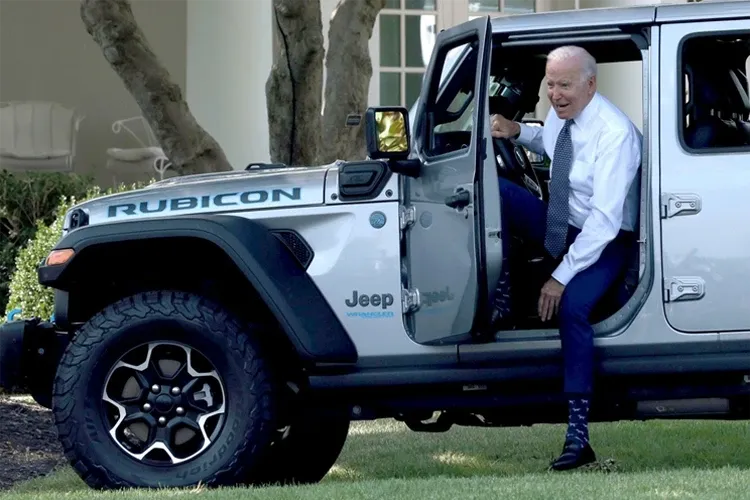A growing number of voices have cast doubt on the feasibility of President Joe Biden’s clean energy overhaul, including some within his own party who have attacked aspects of the plan.
The Biden administration announced yet another massive investment of nearly $1 billion in emissions reductions efforts on Tuesday, this time by upgrading federal buildings. It’s part of his goal to reach net-zero emissions for federal buildings by 2045. More broadly, the commander-in-chief wants a “carbon pollution-free electricity sector by 2035 and a net-zero emissions economy by no later than 2050.”
But it remains to be seen whether the nation’s current and forecasted infrastructure will be sufficient to supply both the electricity and technology necessary for such bold ambitions. The New York Times plainly declared in a headline last week that “the U.S. Electric Grid Isn’t Ready for the Energy Transition.” What followed was an outline of various complications involved in ensuring adequate, interconnected infrastructure.
Studies have indicated that the nation would need to dramatically increase its energy capacity in order to reach Biden’s 2035 target. Referencing one analysis from the National Renewable Energy Laboratory, the outlet said the country would need to more than double its current transmission capacity in the next decade.
It remains to be seen whether the nation’s current and forecasted infrastructure will be sufficient to supply both the electricity and technology necessary for such bold ambitions.
Another study from the American Clean Power Association warned that the nation would achieve only 30% of the clean power needed for Biden’s goal if it continues on the current pace for clean energy installation. That same study found that the nation’s clean power installations declined for the first time in five years, acknowledging “unprecedented investments to modernize our energy systems” but noting “continued headwinds facing the industry.”
Many of the issues cited surround permits and cooperation from regional authorities, which could be addressed by streamlining authority with federal policy. Yet the Biden administration’s sweeping overhaul of the nation’s economy requires cooperation from institutions and policymakers that might not be supportive.
An analysis from The Washington Times found that dozens of congressional Democrats have voted with Republicans and against Biden’s environmental regulations in recent months. Just last week, twenty-nine Democrats backed legislation geared toward blocking the administration’s new energy efficiency standards for stovetops and ovens.
Dozens of congressional Democrats have voted with Republicans and against Biden’s environmental regulations in recent months.
With a Democratic Senate and Biden’s veto power, it’s unlikely that Republican-led attempts to thwart the president’s agenda will succeed. However, they underscore the difficulty in implementing a sweeping, long-term agenda that, even if technically possible, hinges on continuous political support for a series of projects that could be at least initially economically harmful. The tradeoff seems to be especially acute for states like West Virginia, whose congressional delegation has sounded the alarm on the administration’s energy agenda.
“My state is an energy producer and has been an energy producer for over 100 years,” Sen. Joe Manchin (D-WV) said in an interview with The Washington Times. “But the bottom line is the country needs security. The grid needs reliability. We all need to work together to make sure it’s an all-above energy policy.”
So far, certain Democrats have resisted environmental, social, and governance regulations and federal protections on small waterways, among other policies. Democratic Senatorial Campaign Committee Chairman Gary Peters (D-MI) told The Washington Times that “they’re voting the way they think is best for their state.”
The push for greener alternatives has likewise posed geopolitical challenges as the Biden administration seeks a rapid shift toward green energy technology that will likely require more outsourcing to China. That’s part of the reason a bipartisan group of lawmakers recently sought to reimpose tariffs on solar imports from southeast Asia. Despite his administration acknowledging the vulnerability created by Chinese dominance in supplies of minerals necessary for green technology, Biden vetoed the bill while asserting his plan would be enough to counter the reality.
The push for greener alternatives has likewise posed geopolitical challenges as the Biden administration seeks a rapid shift toward green energy technology that will likely require more outsourcing to China.
The Energy Department released a fact sheet last month touting expansions in manufacturing and power supply. Part of Biden’s plan comes in the form of tax credits intended to cushion the transition for consumers and businesses. Yet it’s unclear how effective those will be in encouraging demand for green energy, as the Associated Press recently found that only 19% of poll respondents said it was “very” or “extremely” likely they would purchase an electric vehicle for their next car. And as The New York Times noted in another article, solar projects, which are intended to boost the nation’s energy supply, have come up against low energy supply themselves.
Republican opposition has also complicated the green transition via proposals to repeal renewable energy credits, which contain requirements that may be prohibitive for most companies. Earlier this month, The New York Times quoted an executive from solar project developer Summit Ridge as saying: “There’s not a single solar manufacturer who fully qualifies for this at this moment in time, which makes it difficult and is actually starting to cool investment.”



